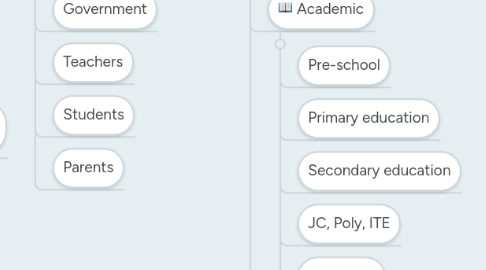Education in Singapore
Door Siti Nursufiani

1. Where: Singapore vs. other system
1.1. Singapore's education system
1.2. Cons
1.2.1. Students who excel at learning are rewarded, those who aren’t are penalized.
1.2.2. Students are spoon fed with knowledge
1.2.3. A total disconnect with the real world
1.2.4. The Bell Curve System
1.2.5. Competition from foreign students
1.2.6. Education syllabus getting harder each year
1.2.7. Obsession over academic results making students uninterested in learning
1.2.8. Obsession with Top Schools
1.2.9. PSLE too early to determine a child’s stream
1.2.10. Streaming in secondary schools is limiting
1.3. Pros
1.3.1. Excellent and highly advanced facilities
1.3.2. Multiracial
1.3.3. Combination of great learning styles
1.3.4. High standard of education
1.3.5. Many different education routes available
1.3.6. Strict
1.3.7. Many subjects available which leads to greater exposure, more fields for a student to explore, more fields to discover his/her interests in
1.3.8. Subsidised education fees for Singaporeans
1.4. Finland's education system
1.4.1. Cons
1.4.1.1. Tougher standards for teachers
1.4.2. Pros
1.4.2.1. Economical background is not an obstacle to participate equally as it is free of charge
1.4.2.2. The school system is 100% state funded.
1.4.2.3. Very careful selection of teachers
1.4.2.4. Teachers are selected from the top 10% of graduates.
1.4.2.5. No educational paths. From ANY secondary school to ANY university
1.4.2.6. There is only one mandatory standardized test in Finland, taken when children are 16.
1.4.2.7. Students in Finland start formal schooling at the age of seven.
1.4.2.8. Students typically start school between 9:00 and 9:45.
1.4.2.9. Teachers have shorter days as well
1.4.2.10. Elementary students in Finland often have the same teacher for up to 6 years of their education.
1.4.2.11. Students only have three to four (or rarely, five) classes a day.
1.4.2.12. Less tests = More learning
1.4.2.13. Topics learnt are spread out so that students can learn more in depth
1.4.2.14. Least amount of homework in the world
1.4.2.15. Fewer students in a class = More individual attention
1.4.2.16. Not stressful for students
2. Who: People in the system
2.1. Government
2.2. Teachers
2.3. Students
2.4. Parents
3. What: Features of the system
3.1. Academic
3.1.1. Pre-school
3.1.2. Primary education
3.1.3. Secondary education
3.1.4. JC, Poly, ITE
3.1.5. University
3.1.6. The education system in Singapore aims to support the development of children’s strengths and social skills. All in all, Singapore’s students produce very good academic results and often pursue excellent careers. Still, the government is constantly working on reforms of the education system in Singapore, in order to remain flexible and guarantee a high quality of education.
3.2. Non-academic
3.2.1. Art
3.2.2. Sports
3.2.3. Music
3.2.4. Many participants felt there is a need for a broader curriculum, one that would help students discover their non-academic strengths and talents. One way to do this would be to adopt a "buffet-style" subject approach in children's early school years, a parent suggested. This would allow them to "sample" and cultivate interest in a range of subjects, like music, art and sports.
4. How: Background
4.1. Education is the essential stepping stone to increased productivity, jobs and economic growth. A proper education brings about a proper workforce. The absence of proper knowledge and skills is directly correlated with poverty and unemployment.
4.2. Sir Thomas Stamford Raffles founded the Singapore Institution (now known as Raffles Institution) in 1823, thereby starting education in Singapore under the British rule.[11] Later, there were three main types of schools appeared in Singapore: Malay schools, Chinese and Tamil (together) schools and English schools.[11] Malay schools were provided free for all students by the British, while English schools, which used English as the main medium of instruction, were set up by missionaries and charged school fees.[11] Chinese and Tamil schools largely taught their respective mother tongues.[11] Students from Chinese schools in particular were extremely attuned to developments in China, especially in the rise of Chinese nationalism.[11] During World War Two, many students in Singapore dropped out of school, causing a huge backlog of students after the war.[12] In 1947, the Ten Years Programme for Education Policy in the Colony of Singapore was formulated.[13] This called for a universal education system that would prepare for self-governance.[12] During the 1950s and 1960s, when Singapore started to develop its own economy, Singapore adapted a "survival-driven education" system to provide a skilled workforce for Singapore's industrialisation programme as well to as to lower unemployment.[14][15] Apart from being an economic necessity, education also helped to integrate the new nation together.[15] The bilingualism policy in schools was officially introduced in 1960, making English the official language for both national integration and utilitarian purposes.[15] Universal education for children of all races and background started to take shape, and more children started to attend schools.[15] However, the quality of schools set up during this time varied considerably.[15] The first Junior College was opened in 1969.[14] In the 1980s, Singapore's economy started to prosper, and the focus of Singapore's education system shifted from quantity to quality.[15] More differentiation for pupils with different academic abilities were implemented, such as revamping vocational education under the new Institute of Technology[15] and splitting of the Normal stream in secondary schools into Normal (Academic) and Normal (Technical) streams.[16] The Gifted Education Programme was also set up to cater to more academically inclined students.[15] In 1997, the Singapore education system started to change into an ability-driven one after then Prime Minister Goh Chok Tong outlined his "Thinking Schools, Learning Nations" vision.[15] Under this policy, more emphasis was given to national education, creative thinking, collaborative learning as well as ICT literacy.[15] Schools became more diverse and were given greater autonomy in deciding their own curriculum and developing their own niche areas.[17] Differences between the various academic streams became blurred.[17] The Ministry of Education also officially acknowledged that "excellence" will not be measured solely in terms of academics; a mountain range of excellence – with many peaks".[17]

